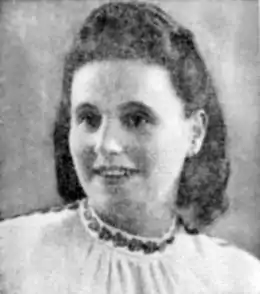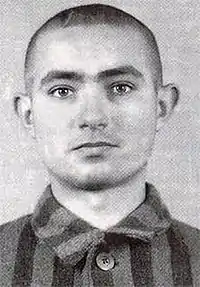Mala Zimetbaum
Malka Zimetbaum, also known as "Mala" Zimetbaum or "Mala the Belgian" (26 January 1918 – 15 September 1944), was a Belgian woman of Polish Jewish descent, known for her escape from the Auschwitz-Birkenau concentration camp and the resistance she displayed at her execution following her being recaptured. She was the first woman to escape from Auschwitz.[1]

Early life and deportation
Mala Zimetbaum was born in Brzesko, Poland, the youngest of five children. When she was ten years old the family relocated to Belgium. In school as a child, she excelled in mathematics and languages. She left school to work in a diamond factory after her father became blind. [1]
At age 24, she was arrested in the third Antwerp raid of 11–12 September 1942 and sent to the Dossin Barracks sammellager in Mechelen. On 15 September 1942 she was put aboard (Belgian) Transport 10 bound for the Auschwitz concentration camp. After the initial Selektion she was sent on to the women's camp at Birkenau. Her registration number was 19880.
Camp life
Zimetbaum spent nearly two years in Auschwitz-Birkenau as Inmate No. 19880. Due to her proficiency in languages – Dutch, French, German, Italian, and Polish – she was assigned work as an interpreter and courier. Other sources state that she was also fluent in Yiddish and Polish.
Although she had a relatively privileged position, Zimetbaum devoted herself to helping other inmates. She interceded to have inmates sent to easier work when she suspected they were not fit for harder labor. She also warned prisoners of coming selections in the infirmary, encouraging them to leave to save their lives. She sneaked photographs that inmates' relatives had sent, out of the files and to the inmates as they were not allowed to have them in the camp. Zimetbaum also got food and medicine for people in need, cheered people up, and encouraged them. She was trusted by staff and prisoners alike.
Failed escape from Auschwitz-Birkenau

A Pole, Edward "Edek" Galiński, who was in love with Zimetbaum, planned to escape from the camp with his friend Wieslaw Kielar (Auschwitz survivor and author of autobiographical book Anus Mundi: 5 Years in Auschwitz[2]). Galinski had worked as a mechanic before being imprisoned, a job which brought him in contact with civilians working around the camp and with the women's prison where he met Zimetbaum. [3] The plan fell through when Kielar lost a pair of SS guard's uniform pants needed as a disguise for their escape. Galiński told his friend that he would escape with Zimetbaum instead and would later find a way to send the uniform back to Kielar for his subsequent escape.
Zimetbaum wanted to escape so that she could inform the Allies of what was going on at Auschwitz and thus save lives. She is said by some sources to have been the head of a resistance group. The escape was planned for Saturday June 24, 1944, when guard would be lighter due to the weekend.[3]
The plan was as follows: Galiński would dress up as an SS guard and escort Zimetbaum through the perimeter gate, pretending he was escorting a prisoner to install a washbasin. Zimetbaum would be carrying a large porcelain washbasin in a way that hid her hair, so the guards they passed would not know it was a woman he was escorting. Galiński would show them a forged pass, and they would be let out. Zimetbaum would be wearing a pair of overalls over a dress that could pass for a men's shirt when inside the overalls. When they got far enough away, Zimetbaum would dump the washbasin, remove the overalls, and wear the dress, and they would pretend to be an SS guard and his girlfriend on a walk.
The plan was put into action in June 1944, and the couple succeeded in escaping to a nearby town. After their escape, Galiński hid nearby as Zimetbaum went into a store to try to buy some bread with gold she and Galiński had stolen from the camp. The passing German patrol became suspicious and arrested Zimetbaum. Galiński watched from a distance as Zimetbaum was arrested.
Knowing she would be killed for the escape, he turned himself in to the German patrol since they had promised not to separate.
Zimetbaum and Galiński were taken to Block 11 in the main camp at Auschwitz, a punishment barracks known as "the Bunker", where they were placed in separate cells. Galiński was eventually put in a group cell with another man. Galiński scratched his and Zimetbaum's names and camp numbers into the cell wall. A friendly guard passed notes to them through a hole in the wall between the cell they were in and an empty one. Sometimes Galiński and Zimetbaum would whistle to each other down the hall. When outside for exercise, Galiński would stand near the window he thought was Zimetbaum's cell window and sing an Italian aria.
Execution
Galiński and Zimetbaum were taken out to be executed at the same time, in the men's and women's camps, respectively.
Galiński jumped into the noose before the verdict was read, but the guards put him back on the platform. Galiński then shouted something to the effect of "Long Live Poland!" The word "Poland" caught in his throat because just then, a guard tipped the stool so that he could hang. One person told all the other prisoners to take their hats off as a respect to Galiński and they all did, to the fury of one guard in particular.
Meanwhile, Zimetbaum took a razor blade out of her hair and slit the veins on the inside of her elbows.
Accounts vary as to what happened next. Some people report she said they would soon be liberated. Others report she shouted at and slapped the guard, proclaiming that she was dying a hero while he would die a dog. Still others state that she shouted at the assembled prisoners to revolt, that it was worth risking their life and if they died trying it was better than the situation they were in now in the camp. She slapped a guard's face with her bloody hand and he grabbed her arm and broke it. The camp staff jumped on her, knocking her to the ground, and taped her mouth shut.
An SS officer named Maria Mandel said that an order from Berlin had come to burn Zimetbaum alive in the crematorium. They put her on a wheelbarrow and selected several prisoners from the front of the group of onlookers to take her to the nearby camp infirmary. The nurses bandaged her arms as slowly as possible, trying to make her die as quickly as possible. Zimetbaum said weakly to the assembled prisoners, "The day of reckoning is near".
On the way to the crematorium, Zimetbaum told the women pulling the handcart she was on that she knew she could have survived, but she chose not to because she wanted to follow what she believed in.
Accounts of her death differ. Some said she bled to death on the cart. Others report that a guard took pity on her and shot or poisoned her in the crematorium. Still others observe she had poison on her and took it before she could be burned alive.
The prisoners forced to cremate the corpses had been informed that Zimetbaum was arriving, and they made special preparations. They prayed and cried as they burned her remains. The prisoners who had pulled the handcart then went back to the barracks and told other prisoners what they had witnessed.
Testimonial account
Information regarding Zimetbaum was made available to the public in the official testimony of Mrs Raya Kagan, delivered on 8 June 1961, during Session 70 in the trial of Adolf Eichmann, in Jerusalem.[4]
After World War II, little is known of the surviving members of the Zimetbaum Hartman family. Zimetbaum's siblings, Gitla, Marjem, and Salomon Rubin, survived the Nazi Holocaust. It is also known that Gitla migrated to and died in Guayaquil, Ecuador, and that her direct descendants are all aware of Zimetbaum's legacy.
Mala, The Music of the Wind
In January 2002, a musical based on the life of Zimetbaum, titled Mala, The Music of the Wind, opened at the Pallas Theatre in Athens, Greece, starring Greek pop singer Anna Vissi.
Vissi's closest collaborator, Nikos Karvelas, wrote the play, the music and the lyrics for the show. Vissi spoke of the performance at a press conference before the show's premiere:
The story of Mala Zimetbaum is real and relates one of the most terrible moments for humanity in the 20th century. Saturday will be a test for me and I am both anxiously and happily looking forward to passing it; to convince the audience that I am Mala rather than Vissi.[5]
The director, Yiannis Kakleas, described it as "an ambitious production that will carve new roads for Greek theatrical productions".[5]
A CD single was released in Greece and Cyprus containing four tracks from the performance. A complete album of the soundtrack containing 27 tracks, all written and produced by Nikos Karvelas with orchestration/instrumentation by Giorgos Niarhos was later released.
The Last Stage
The Last Stage is a 1947 Polish feature film set in the Auschwitz concentration camp, directed and co-written by Wanda Jakubowska. The main character, Marta Weiss, is based on the true story of Mala Zimetbaum. The film honours her life as a Belgium Jew deported to Auschwitz in 1942. She was then selected to work there as an interpreter using her multilingual fluency. She was executed after her failed escape bid.
Seventy two years after it was first shown in Poland, it was screened as part of the Israeli Polish Zoom events, a project of the Polish Institute in Tel Aviv and the Adam Mickiewicz Institute in Poland. A 2019 review[6] of the film was published in the Haaretz newspaper.
Sources
- "Captured SS deportation files for Belgium as well as numerous photographs and personal records". Jewish Museum of Deportation and Resistance, Documentation Centre. Mechelen, Belgium. Archived from the original on 2011-07-06.
- "Der erste Frankfurter Auschwitz-Prozess". Fritz Bauer-Institute (in German). Berlin. 2004. Missing or empty
|url=(help) - Gutman, Israel (1990). "Mala Zimetbaum". Encyclopedia of the Holocaust (in Hebrew). 4. New York: Macmillan. p. 1037.
- Huber, Gérard (2006). "Préface de Simone Veil". Book Review: Mala. Une Femme Juive Héroique dans le Camp d'Auschwitz-Birkenau (in French) (Éditions du Rocher ed.). ISBN 2-268-05863-8.
- Sichelschmidt, Lorenz (1995). Mala. Ein Leben und eine Liebe in Auschwitz (in German). Bremen. ISBN 3-924444-89-7.
References
- Jewish Women's Archive https://jwa.org/encyclopedia/article/zimetbaum-mala. Retrieved 31 December 2019. Missing or empty
|title=(help) - Kielar, Wieslaw (November 1980). Anus Mundi: 1,500 Days in Auschwitz/Birkenau (1st ed.). Times Books. ISBN 978-0812909210.
- Sichelschmidt, Lorenz. "Mala - A Fragment of a Life". Idea - A Journal of Social Issues. Retrieved 31 December 2019.
- "Official Testimony of Mrs. Raya Kagan". Transcripts of the Trial of Adolf Eichmann, Session 70. Jerusalem. June 8, 1961.
- PANAGOPOULOS, PANAYIOTIS. "Mala's tragic fate draws Vissi back to the stage". Ekathimerini. Retrieved 2019-06-11.
- Ofer Aderet, "How the Very First Holocaust Film Was Forgotten and Rediscovered", Haaretz, Sep 13, 2019, Hebrew language version, subscription required
External links
- "Mala Zimetbaum". Holocaust Survivors and Remembrance Project: "Forget You Not".
- Sichelschmidt, Lorenz. "Mala – A Fragment of a Life". ideajournal.
- Esrati, Stephen G. "Mala's Last Words". ideajournal.
- "Bios". Women of Valor: Partisans and Resistance Fighters. Archived from the original on 2006-08-23.
- "Online Multimedia Learning Center". Museum of Tolerance.
- Sichelschmidt, Lorenz. "Companion photographs of Mala Zimetbaum". ideajournal.com.
- "Love in the Shadow of Death". Episodes from Auschwitz. The story of Edek and Mala's escape from Auschwitz presented as a graphic history.
- Mala Zimetbaum at Find a Grave
- "Tragic Love at Auschwitz: The love story between Mala Zimetbaum and Edek Galinski together with their eventual failed escape from Auschwitz". Google Cultural Institute.
